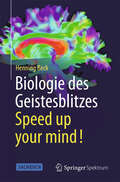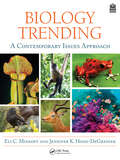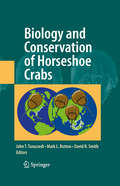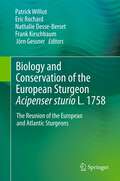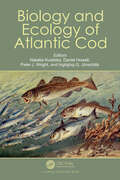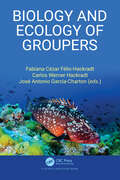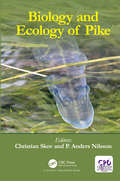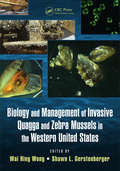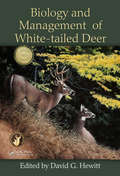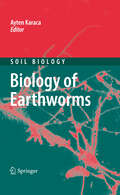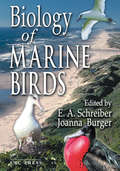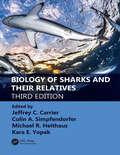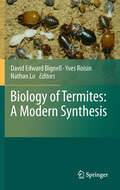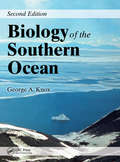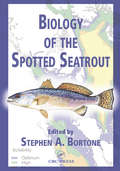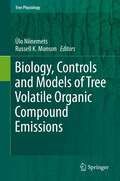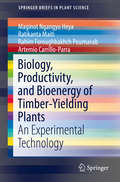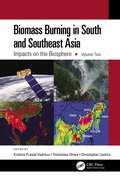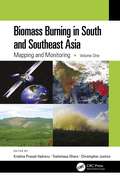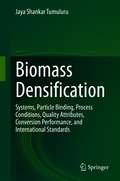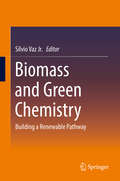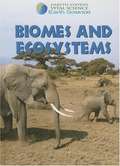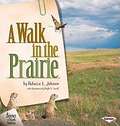- Table View
- List View
Biological Response Signatures: Indicator Patterns Using Aquatic Communities
by Thomas P. SimonThe use of environmental assessment procedures within monitoring frameworks demands that there be some relevancy to the decisions that management agencies make using biological criteria. These biological criteria standards are the basis for environmental indicators, which provide a direct measure of environmental quality. Biological Response Signat
Biologie des Geistesblitzes - Speed up your mind!
by Henning BeckDenken Sie, das Gehirn ist eine perfekte Rechenmaschine, die evolutionäre Krone aller Informationssysteme, die komplexeste Struktur des Universums, präziser und leistungsfähiger als jeder Computer? Vergessen Sie das sofort! Das Gehirn ist ein Haufen voller eitler, fauler und selbstverliebter Zellen, die sich ständig verrechnen und dabei noch permanent von ihren Nachbarn abgelenkt werden. Da hält man es kaum für möglich und doch geschieht das Wunder: Das Gehirn funktioniert! Sehr gut sogar, denn Menschen sind im Gegensatz zu rechnenden Maschinen ausgesprochen kreativ. "Wie das?", mag man fragen und dieses Buch gibt die Antwort darauf. Fachlich fundiert und locker aufbereitet berichtet der deutsche Science Slam-Meister 2012 Henning Beck über das Zusammenspiel von Nerven- und ihren Helferzellen, erklärt, was ein Geistesblitz überhaupt ist, wie er entsteht und was die Hirnforschung zum Thema Kreativität zu sagen hat.
Biology Trending: A Contemporary Issues Approach
by Eli Minkoff Jennifer K. Hood-DeGrenierBiology Trending is a truly innovative introductory biology text. Designed to combine the teaching of biological concepts within the context of current societal issues, Biology Trending encourages introductory biology students to think critically about the role that science plays in their world. This book features many current and relevant topics, including sea-level changes and ocean acidification; CRISPR/Cas9, opioid abuse, Zika, Ebola, and COVID-19; threats to biodiversity, and cancer immunotherapies. It is accompanied by digital Instructor and Student Resources to support teaching and learning.Key Features Adopts an "issues approach" to teaching introductory biology Up-to-date sections throughout, including climate change, CRISPR, new hominids, COVID-19, and new cancer therapies, among many others Suitable for both major and nonmajor courses More succinct for ease in teaching and more affordable for students High-quality illustrations help to elucidate key concepts This book is extended and enhanced through a range of digital resources that include: Long-form and open-response self-testing resources to test understanding and apply knowledge Visual simulations to demonstrate evolutionary processes Web links and bibliographic resources to expand knowledge Time-saving instructor resources such as PowerPoint slides, activity and assignment ideas, and comprehensive lesson plans Related TitlesBard, J. Evolution: The Origins and Mechanisms of Diversity (ISBN 9780367357016).Prothero, D. Vertebrate Evolution: From Origins to Dinosaurs and Beyond (ISBN 9780367473167)Johnson, N. A. Darwin’s Reach: 21st Century Applications of Evolutionary Biology (ISBN 9781138587397)
Biology and Conservation of Horseshoe Crabs
by David Smith Mark L. Botton John T. TanacrediThe four living species of horseshoe crabs face a set of growing threats to their survival, including the erosion and/or man-made alteration of essential spawning habitat, coastal pollution, and overfishing. Horseshoe crabs are "living fossils", with a more than 200 million year evolutionary history. Their blood provides a reagent, known as Limulus amebocyte lysate or LAL, that clots in the presence of minute quantities of bacterial endotoxin; the LAL test is the state-of-the-art methodology used to ensure that pharmaceuticals and surgical implants are free of contamination. Horseshoe crabs are an integral part of the food web in coastal marine ecosystems, and their eggs provide essential food for shorebirds in the Delaware Bay estuary each spring. The commercial fishery for horseshoe crabs, which utilizes animals for bait, contributes to the economies of coastal communities. This book consists of papers presented at the 2007 International Symposium on the Science and Conservation of Horseshoe Crabs.
Biology and Conservation of the European Sturgeon Acipenser sturio L. 1758: The Reunion of the European and Atlantic Sturgeons
by Eric Rochard Frank Kirschbaum Jörn Gessner Nathalie Desse-Berset Patrick WilliotThe book aims at synthesizing our current knowledge of Acipenser sturio and its management. This species, one of the most widespread sturgeon species all over Western Europe ranging from the Black Sea to the Baltic, is now on the verge of extinction. Major aspects of its biology and management, including mismanagement, are provided in a historic perspective. Similarly, the changes in the restoration programs (in situ and ex situ) initiated in France and Germany are presented. As the species occurred in sympatry with Acipenser oxyrinchus in Germany and Poland and very recently in France as well, a brief outlook on restoration-management programs of A. oxyrinchus are also provided for both North America and Northern European countries, namely Germany and Poland. As conservation-restoration actions go beyond scientific issues, non-governmental stakeholders and marine professional fishermen's organizations have also been asked to contribute, and the key role of a French-German cooperation plan is underlined. A part of the book is devoted to perspectives. Illustrations of the European sturgeon, mainly in photographs, but also in stamps and paintings, are presented.
Biology and Ecology of Atlantic Cod
by Peter J. Wright Daniel Howell Nataliia Kulatska Ingibjörg G. JónsdóttirAtlantic cod is an important fish species in human history and continues to be a major influence on North Atlantic fisheries management, as stock collapses and recoveries impact coastal communities and shelf sea food webs. This book provides an overview of Atlantic cod biology and ecology, focussing on regional differences in life-history and stock dynamics that affect productivity and the challenges faced by management. By comparing the success of management approaches and the local influence of changing climate and food webs, the book highlights the different pressures facing stocks and identifies knowledge gaps across the species’ range.
Biology and Ecology of Groupers
by Fabiana Cézar Félix-HackradtGroupers are fascinating charismatic fishes commonly found in reef habitats around the world that sustain a global multimillionaire fishery. They are an important top predator species and therefore of paramount ecological importance for reef systems' resilience. The book, Biology and Ecology of Groupers is an up-to-date review of the main bio-ecological topics involving worldwide groupers species oriented to the academic community and managers. It covers aspects of classification and phylogenetic relationships, geographical distribution, and life history related characteristics (Section I), including the major threats of groupers populations, case studies of successful management and comments about the future of groupers in our changing world (Section II).
Biology and Ecology of Pike
by Christian Skov P. Anders NilssonThis book sets out to bridge the order scales among pike researchers, populations, communities, management, and fisheries. It emphasizes the progress of pike research during the last two decades, during which the order-bridging approach emerged. This framework underpins the text and the message, to convey its importance to pike research and to fish research in general. In addition, a considerable part of the book is devoted to management implications and highlights aspects of human dimensions in recreational fisheries.
Biology and Management of Invasive Quagga and Zebra Mussels in the Western United States
by Wai Hing Wong Shawn L. GerstenbergerBiology and Management of Invasive Quagga and Zebra Mussels in the Western United States is a synthesis of the biology and management of invasive mussels from scientists and managers working on invasive quagga and zebra mussels in the western United States. Invasive dreissenid mussels have spread throughout southwestern United States at unprecedent
Biology and Management of White-tailed Deer
by David G. HewittWinner of the Wildlife Society Outstanding Edited Book Award for 2013!Winner of the Texas Chapter of The Wildlife Society Outstanding Book Award for 2011!Winner of a CHOICE Outstanding Academic Title Award for 2011!Biology and Management of White-tailed Deer organizes and presents information on the most studied large mammal species in the world. The book covers the evolutionary history of the species, its anatomy, physiology, and nutrition, population dynamics, and ecology across its vast range (from central Canada through northern South America). The book then discusses the history of management of white-tailed deer, beginning with early Native Americans and progressing through management by Europeans and examining population lows in the early 1900s, restocking efforts through the mid 1900s, and recent, overabundant populations that are becoming difficult to manage in many areas. Features: Co-published with the Quality Deer Management Association Compiles valuable information for white-tailed deer enthusiasts, managers, and biologists Written by an authoritative author team from diverse backgrounds Integrates white-tailed deer biology and management into a single volume Provides a thorough treatment of white-tailed deer antler biology Includes downloadable resources with color images The backbone of many state wildlife management agencies' policies and a featured hunting species through much of their range, white-tailed deer are an important species ecologically, socially, and scientifically in most areas of North America. Highly adaptable and now living in close proximity to humans in many areas, white-tailed deer are both the face of nature and the source of conflict with motorists, home-owners, and agricultural producers. Capturing the diverse aspects of white-tailed deer research, Biology and Management of White-tailed Deer is a reflection of the resources invested in the study of the species’ effects on ecosystems, predator-prey dynamics, population regulation, foraging behavior, and browser physiology.
Biology and Management of the World Tarpon and Bonefish Fisheries
by Jerald S. AultThe core of a multibillion dollar sport fishing industry, tarpon and bonefish, two of the earth's oldest creatures, are experiencing obvious and precipitous population decline. Experienced anglers in the Florida Keys suggest a drop of approximately 90-95 percent for the bonefish population over the last 65 years. Despite the economic value of the i
Biology of Earthworms (Soil Biology #24)
by Ayten KaracaEarthworms, which belong to the order Oligochaeta, comprise roughly 3,000 species grouped into five families. Earthworms have been called 'ecosystem engineers'; much like human engineers, they change the structure of their environments. Earthworms are very versatile and are found in nearly all terrestrial ecosystems. They play an important role in forest and agricultural ecosystems. This Soil Biology volume describes the various facets of earthworms, such as their role in soil improvement, soil structure, and the biocontrol of soil-borne plant fungal diseases. Reviews discuss earthworms' innate immune system, molecular markers to address various issues of earthworm ecology, earthworm population dynamics, and the influences of organic farming systems and tillage. Further topics include the characteristics of vermicompost, relationships between soil earthworms and enzymes, the role of spermathecae, copulatory behavior, and adjustment of the donated sperm volume.
Biology of Marine Birds (CRC Marine Biology Series)
by Joanna Burger E. A. SchreiberBiology of Marine Birds provides the only complete summary of information about marine birds ever published. It analyzes their breeding biology, ecology, taxonomy, evolution, fossil history, physiology, energetics, and conservation. The book covers four orders of marine birds in detail and includes two summary chapters that address the biology of shorebirds and wading birds and their lives in the marine environment. Summary tables give detailed information on various aspects of their life histories, breeding biology, physiology and energetics, and demography. It provides a guide to ornithologists and students for research projects.
Biology of Sharks and Their Relatives (CRC Marine Biology Series)
by Michael R. Heithaus Colin A. Simpfendorfer Jeffrey C. Carrier Kara E. YopakBiology of Sharks and Their Relatives is an award-winning and groundbreaking exploration of the fundamental elements of the taxonomy, systematics, physiology, and ecology of sharks, skates, rays, and chimera. This edition presents current research as well as traditional models, to provide future researchers with solid historical foundations in shark research as well as presenting current trends from which to develop new frontiers in their own work. Traditional areas of study such as age and growth, reproduction, taxonomy and systematics, sensory biology, and ecology are updated with contemporary research that incorporates emerging techniques including molecular genetics, exploratory techniques in artificial insemination, and the rapidly expanding fields of satellite tracking, remote sensing, accelerometry, and imaging. With two new editors and 90 contributors from the US, UK, South Africa, Portugal, France, Canada, New Zealand, Australia, India, Palau, United Arab Emirates, Micronesia, Sweden, Argentina, Indonesia, Cameroon, and the Netherlands, this third edition is the most global and comprehensive yet. It adds six new chapters representing extensive studies of health, stress, disease and pathology, and social structure, and continues to explore elasmobranch ecological roles and interactions with their habitats. The book concludes with a comprehensive review of conservation policies, management, and strategies, as well as consideration of the potential effects of impending climate change. Presenting cohesive and integrated coverage of key topics and discussing technological advances used in modern shark research, this revised edition offers a well-rounded picture for students and researchers.
Biology of Termites: A Modern Synthesis
by David Edward Bignell Yves Roisin Nathan LoBiology of Termites, a Modern Synthesis brings together the major advances in termite biology, phylogenetics, social evolution and biogeography. In this new volume, David Bignell, Yves Roisin and Nathan Lo have brought together leading experts on termite taxonomy, behaviour, genetics, caste differentiation, physiology, microbiology, mound architecture, biogeography and control. Very strong evolutionary and developmental themes run through the individual chapters, fed by new data streams from molecular sequencing, and for the first time it is possible to compare the social organisation of termites with that of the social Hymenoptera, focusing on caste determination, population genetics, cooperative behaviour, nest hygiene and symbioses with microorganisms. New chapters have been added on termite pheromones, termites as pests of agriculture and on destructive invasive species.
Biology of the Southern Ocean (CRC Marine Biology Series)
by George A. KnoxFirst published in 1993, The Biology of the Southern Ocean has been referred to as international research at its best and an invaluable reference. Drawing on the considerable volume of information published in the last ten years, this second edition retains the format that made the first edition a popular bestseller, while updating the information
Biology of the Spotted Seatrout (CRC Marine Biology Series)
by Stephen A. BortoneThe spotted seatrout is an important species not only for recreational and commercial fisheries, but also as an integral part of many estuarine ecosystems. As one of the few fishes that live its entire life within an estuarine system, the species has tremendous potential as a monitor or sentinel for estuarine conditions. Prepared by the foremost au
Biology, Controls and Models of Tree Volatile Organic Compound Emissions (Tree Physiology #5)
by Russell K. Monson Ülo NiinemetsPlant-driven volatile organic compound (BVOC) emissions play a major role in atmospheric chemistry, including ozone and photochemical smog formation in the troposphere, and they extend the atmospheric lifetime of the key greenhouse gas, methane. Furthermore, condensation of photo-oxidation products of BVOCs leads to formation of secondary organic aerosols with profound implications for the earth's solar radiation budget and climate. Trees represent the plant life form that most contributes to BVOC emissions, which gives global forests a unique role in regulating atmospheric chemistry. Written by leading experts in the field, the focus is on recent advancements in understanding the controls on plant-driven BVOC emissions, including efforts to quantitatively predict emissions using computer models, particularly on elicitation of emissions under biotic and abiotic stresses, molecular mechanisms of volatile synthesis and emission and the role of emissions in plant stress tolerance.
Biology, Productivity and Bioenergy of Timber-Yielding Plants: An Experimental Technology (SpringerBriefs in Plant Science)
by Ratikanta Maiti Maginot Ngangyo Heya Rahim Foroughbakhch Pournavab Artemio Carrillo-ParraFace to the current global energy crisis, there is an urgent necessity of searching for alternatives to fossil fuels, and this book shows how timber is a promising resource for sustainable energy production. Northeast Mexico represents an important forest resource to satisfy the needs of the population in these areas. In order to harness these forest resources, technology for exploring these valuable resources must be developed. These technologies (with special reference to biology and wood technologies) are available in scattered form in a few books but there is no central, comprehensive source for practical forest scientists for adopting efficient forest management, practice, and exploration. This book deals with the characterization of the vegetation, morphology, phenological development, biomass production (leaf, litter, wood), and bioenergy of some timber-yielding species of Northeast Mexico, which will serve as a guide to study timber-yielding plants in the native vegetation of Tamaulipan thornscrub and experimental plantations. This includes morphology, vegetation cover, biomass production in terms of volume leaf biomass, litter, and volume of fire wood and timber. Special emphasis is given to the estimation of bioenergy products and chemical composition (Ph, extractable lignin, and inorganic elements). Large variations exist in vegetation cover, morphology, phenological development, biomass production of leaf and litter, volume of wood and various variable of bioenergy products among the selected species. The maximum production was found in summer and the volume of the harvestable timber was obtained in experimental plantations. This book, therefore, will serve as a practical handbook to characterize timber-yielding plants, which will help to efficiently manage forestry resources.
Biomass Burning in South and Southeast Asia: Impacts on the Biosphere, Volume Two
by Krishna Prasad Vadrevu Toshimasa Ohara Christopher JusticeBiomass burning is one of the most important sources of greenhouse gas emissions and aerosols in South and Southeast Asia and greatly impacts other countries through transboundary air pollution. With contributions from leading scientists, this volume offers an interdisciplinary perspective on the impacts of biomass burning on the land resources, climate, and the atmosphere. It showcases several examples linking top-down remote sensing, bottom-up ground-based measurements, and an integrated modeling to address the impacts of biomass burning and land–atmosphere interactions. It is a valuable guide for readers in atmospheric science, ecology, spatial geography, remote sensing, and GIS. This book is unique as it highlights the sources and the causes of biomass burning and atmospheric research in South and Southeast Asia. It explains the latest tools and techniques, in particular the use of satellite remote sensing and geospatial technologies for fire mapping, monitoring, and land cover/land use change. It focuses on large spatial scales integrating top-down and bottom-up methodologies. It addresses the pressing issues of air pollution rampant in South and Southeast Asia. It includes contributions from global experts working on biomass burning projects in the USA, Japan, South/Southeast Asia, and Europe. The contents of this book will appeal to students and professionals using remote sensing and geospatial techniques, including geographers, ecologists, atmospheric and environmental scientists, and all who are interested in biomass burning pollution.
Biomass Burning in South and Southeast Asia: Mapping and Monitoring, Volume One
by Krishna Prasad Vadrevu Toshimasa Ohara Christopher JusticeVolume 1 of a two volume set, this book is a self-contained, state-of-the-art analysis of remote sensing, ground-based, and spatial techniques used for characterizing biomass burning events and pollution. It is a collective achievement of renowned scientists working throughout South and Southeast Asia. They discuss the complexity of vegetation patterns, biomass characteristics, fire distribution, drivers of fires, and several examples of the use of novel satellite algorithms for mapping and monitoring biomass burning events. The book is highly interdisciplinary and integrates earth science and environmental science including ecology, fire science, spatial geography, remote sensing, and geospatial technologies. Unique in its discussion of the sources and the causes of biomass burning and atmospheric research in South and Southeast Asia. Explains how remote sensing and geospatial technologies help the mapping and monitoring of biomass burning events and their impacts. Focuses on large spatial scales integrating top-down and bottom-up methodologies. Addresses the pressing issues of environmental pollution that are rampant in South and Southeast Asia. Includes contributions from global experts actually working on biomass burning projects in the US, Japan, South/Southeast Asia, and Europe. This book will serve as a valuable source of information for remote sensing scientists, geographers, ecologists, atmospheric scientists, environmental scientists, and all who wish to advance their knowledge on fires and biomass burning in South/Southeast Asia.
Biomass Densification: Systems, Particle Binding, Process Conditions, Quality Attributes, Conversion Performance, and International Standards
by Jaya Shankar TumuluruThis monograph discusses the various biomass feedstocks currently available for biofuels production, and mechanical preprocessing technologies to reduce the feedstock variability for biofuels applications. Variability in the properties of biomass—in terms of moisture, particle size distribution, and low-density—results in storage, transportation, handling, and feeding issues. Currently, biorefineries face serious particle bridging issues, uneven discharge, jamming of equipment, and transportation problems. These issues must be solved in order for smooth operations to be possible. Mechanical preprocessing technologies, such as size reduction, densification, and moisture management using drying and dewatering, can help to overcome these issues. Many densification systems exist that will assist in converting low-density biomass to a high-density commodity type feedstock. In 6 chapters, the impact of densification process variables, such as temperature, pressure, moisture, etc., on biomass particle agglomeration, the quality of the densified products, and the overall energy consumption of the process are discussed, as are the various compression models for powders that can be used for biomass particles agglomeration behavior and optimization of the densification process using statistical and evolutionary methods. The suitability of these densified products for biochemical and thermochemical conversion pathways is also discussed, as well as the various international standards (CEN and ISO) they must adhere to. The author has worked on biomass preprocessing at Idaho National Laboratory for the last ten years. He is the principal investigator for the U.S. Department of Energy Bioenergy Technologies Office-funded “Biomass Size Reduction and Densification” project. He has developed preprocessing technologies to reduce cost and improve quality. The author has published many papers and books focused on biomass preprocessing and pretreatments. Biomass process engineers and biorefinery managers can benefit from this book. Students in chemical, mechanical, biological, and environmental engineering can also use the book to understand preprocessing technologies, which greatly assist in improving the biomass critical material attributes. The book can help policymakers and energy systems planners to understand the biomass properties limitations and technologies to overcome the same.
Biomass and Green Chemistry
by Sílvio Vaz Jr.This book investigates the main vegetable biomass types, their chemical characteristics and their potential to replace oil as raw material for the chemical industry, according to the principles of green chemistry. Authors from different scientific and technical backgrounds, from industry and academia, give an overview of the state of the art and ongoing developments. Aspects including bioeconomy, biorefineries, renewable chemistry and sustainability are also considered, given their relevance in this context. Furthermore, the book reviews green chemistry principles and their relation to biomass, while also exploring the main processes for converting biomass into bioproducts. The need to develop renewable feedstock for the chemical industry to replace oil has been identified as a major strategic challenge for the 21st century. In this context, the use of different types of vegetable biomass – starch, lignocellulosic, oleaginous, saccharide and algae – can be seen as a viable alternative to the use of non-renewable, more expensive raw materials. Furthermore, it offers a model for adding economic value to the agro industrial chains such as soybean, sugarcane, corn and forests, among others. This will in turn contribute to the sustainability of a wide range of chemicals, mainly organics and their transformation processes, which are widely used by modern society.
Biomes and Ecosystems
by Barbara J. DavisGareth Stevens Vital Science books are designed to help prepare students for NCLB science testing by reinforcing key concepts across the science curriculum. the six volumes in Earth Science use clear language and a variety of photographs, illustrations, and diagrams to help students understand the properties of rocks, soils, water, gases, and fossils. Weather, biomes and ecosystems, and earth's core and crust are also covered, making this a comprehensive and indispensable resource. image descriptions present
Biomes of North America: A Walk In The The Prairie
by Rebecca L. JohnsonTake a walk through the prairie. This biome of tall grass and open sky is teeming with life. How do the plants and animals of the prairie survive? As you travel through the prairie, watch closely to understand how each living creature is part of a circle of life.

